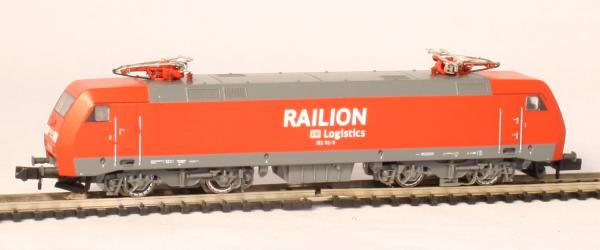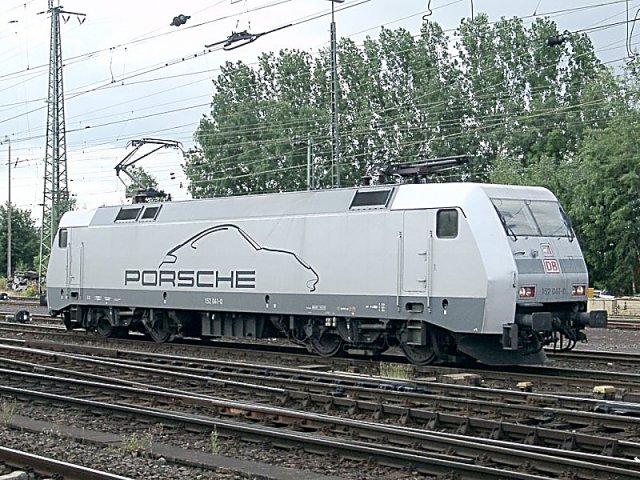Model Information: Directional headlights
DCC Information: It is DCC Ready, configured to accept standard NMRA 6-pin (NEM 651) decoder.
Prototype History: The EuroSprinter family of electric locomotives is a modular concept of locomotives for the European market built by Siemens. The internal Siemens product name is ES 64, with ES for EuroSprinter and the number 64 indicating the 6,400 kW power at rail.
Additional information is given in the name on the usage (U as universal, P as prototype and F as freight) and on the number of electric power systems supported.
The ES 64 F is an electric freight locomotive with 6,400 kW (8,600 hp) power and a top speed of 140 km/h (87 mph). Though it is equipped for passenger services, it is exclusively used for freight trains. It was introduced to Deutsche Bahn AG as Class 152 in 1996 and today is operated by DB Schenker Rail. Its main role is to replace the older Class 150 and Class 151 locomotives on heavy freight trains. The original German order of 195 units was reduced to 170, as the ÖBB decided that the track forces generated as a result of using nose-suspended traction motors exceeded standards and refused to certify them for use in Austria. Instead, DB AG changed the remaining 25 locomotives to Siemens model ES 64 U2 which were assigned as Class 182 (ÖBB BR 1116).
From Wikipedia
Read more (in German) about ES64F
The ES 64 F is an electric freight locomotive with 6,400 kW (8,600 hp) power and a top speed of 140 km/h (87 mph). Though it is equipped for passenger services, it is exclusively used for freight trains. It was introduced to Deutsche Bahn AG as Class 152 in 1996 and today is operated by DB Schenker Rail. Its main role is to replace the older Class 150 and Class 151 locomotives on heavy freight trains. The original German order of 195 units was reduced to 170, as the ÖBB decided that the track forces generated as a result of using nose-suspended traction motors exceeded standards and refused to certify them for use in Austria. Instead, DB AG changed the remaining 25 locomotives to Siemens model ES 64 U2 which were assigned as Class 182 (ÖBB BR 1116).
From Wikipedia
Read more (in German) about ES64F
Road Name History: On January 1, 2000, Railion GmbH, headquartered in Mainz, Germany, was set up by Deutsche Bahn AG and the Dutch company Nederlandse Spoorwegen (NS) to provide rail freight transport activities as 100% subsidiary companies of Railion GmbH. DB Cargo became Railion Deutschland AG and NS Cargo became Railion Benelux NV. Later this company was renamed Railion Nederland NV.
In December 2007 Railion became part of the DB Schenker logistics group, itself a subsidiary of Deutsche Bahn. In early 2009 the now larger division was renamed DB Schenker Rail, and once again in 1 March 2016 to its current name, DB Cargo.
DB Cargo is a European (mainly German) railway cargo carrier. The company was formed from the freight operating section of the Deutsche Bahn with the addition of various European rail freight operating companies.
Read more on Wikipedia.
In December 2007 Railion became part of the DB Schenker logistics group, itself a subsidiary of Deutsche Bahn. In early 2009 the now larger division was renamed DB Schenker Rail, and once again in 1 March 2016 to its current name, DB Cargo.
DB Cargo is a European (mainly German) railway cargo carrier. The company was formed from the freight operating section of the Deutsche Bahn with the addition of various European rail freight operating companies.
Read more on Wikipedia.
Brand/Importer Information: Founded in 1906 by Karl Arnold in Nürnberg, K. Arnold & Co. began its life producing tin toys and related items. They produced an extensive line of model ships, doll house items and other toys. In 1935, K. Arnold & Co. hired Max Ernst as their managing director. Ernst, not to be confused with the German realist artist of the same name, was a significant factor in the future of Arnold.
On Max Ernst's 1976 retirement, Arnold employed perhaps 200 to 250 people, using three facilities in the Nuernberg area. The Company continued under family control until 1995, when Arnold went into bankruptcy and was sold to Rivarossi of Italy. Rivarossi, in turn, also went bankrupt, leading to the sale of all assets to Hornby of the United Kingdom. Production is carried out in China.
From Wikipedia
On Max Ernst's 1976 retirement, Arnold employed perhaps 200 to 250 people, using three facilities in the Nuernberg area. The Company continued under family control until 1995, when Arnold went into bankruptcy and was sold to Rivarossi of Italy. Rivarossi, in turn, also went bankrupt, leading to the sale of all assets to Hornby of the United Kingdom. Production is carried out in China.
From Wikipedia
Item created by: gdm on 2017-09-04 19:37:09
If you see errors or missing data in this entry, please feel free to log in and edit it. Anyone with a Gmail account can log in instantly.
If you see errors or missing data in this entry, please feel free to log in and edit it. Anyone with a Gmail account can log in instantly.











